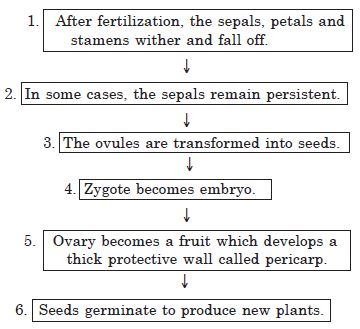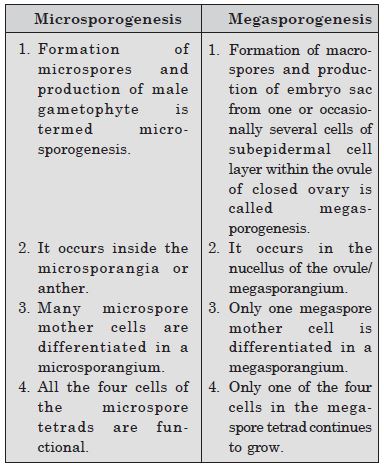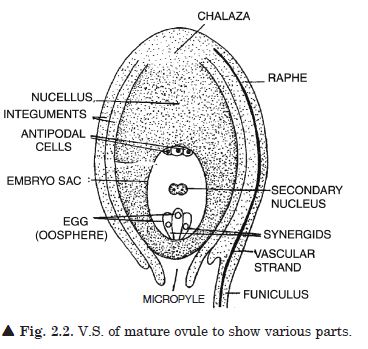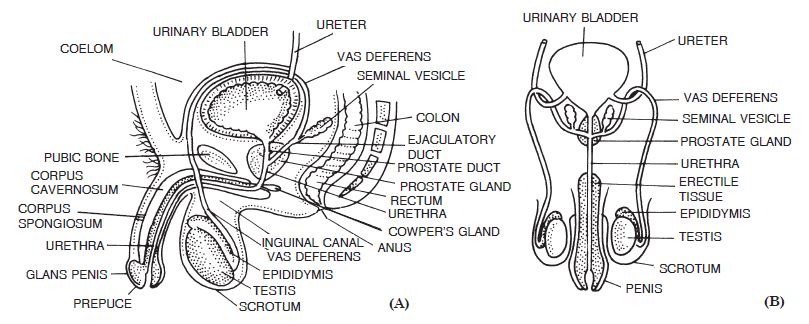Question 1:
Identify each part and write whether it is haploid (n) or diploid (2n).
(a) Ovary (b) Anther (c) egg (d) pollen (e) male gamete (f) zygote.
Answer:
(a) Ovary → diploid (2n)
(b) Anther → diploid (2n)
(c) Egg → haploid (n)
(d) Pollen → haploid (n)
(e) Male gamete→ haploid (n)
(f) Zygote→ diploid (2n).
Question 2:
Describe the post-fertilization changes in a flower.
Answer:
Post fertilization changes in a flower

Question 3:
Name the parts of angiospermic flower in which development of male and female gametophyte take place.
Answer:
(i) Development of Male gametophyte takes place inside the pollen grains released from
microsporangium or anther.
(ii) Development of female gametophyte from megaspore occurs in ovule of ovary.
Question 4:
Differentiate between microsporogenesis and megasporogenesis. Which type of cell division occurs during these events? Name the structures formed at the end of these two events.
Answer:
(i) Differences between microsporogenesis and megasporogenesis

(ii) Meiosis (Reduction division occurs during these two processes).
(iii) (a) Microspore (b) Megaspore.
Question 5:
Arrange the following terms in a correct development sequence: Pollen grain, sporogenous tissue, microspore tetrad, pollen mother cell, male gamete.
Answer:
1. Sporogenous tissue
2 Pollen mother cell
3. Microspore tetrad
4. Pollen grain
5. Male gamete.
Question 6:
With a neat labelled diagram, describe the parts of a typical angiosperm ovule.
Answer:
Structure of ovule. Each ovule consists of nucellus surrounded by two integuments and a stalk
or funiculus.
(i) Funiculus is stalk-like structure by which ovule is attached to the placenta.
(ii) Hilum. It is the point of attachment of the body of the ovule with the funiculus.
(iii) Raphe. It is the longitudinal ridge formed by lengthwise fusion of funiculus with the
body of ovule in a typical anatropous ovule.
(iv) Nucellus. It is a mass of diploid cell called megasporangium. It provides nourishment
in the development of embryo sac.
(v) Embryo sac. It is the female gametophyte which contains the egg apparatus. antipodal and
polar nuclei.

(vi) Integuments form seed coats i.e. testa and tegmen.
(vii) Micropyle. It is small opening which is left by the integument in the ovule for the
passage of pollen tube into the ovule.
(viii) Chalaza. The basal region of ovule from where the integuments arise is called
chalaza.
Question 7:
What do you mean by monosporic development of female gametophyte?
Answer:
In monosporic development as in (Polygonum) the development of embryo sac, only one megaspore situated towards chalazal end remains functional. The remaining three megaspores gradually degenerate and finally disappear. The functional haploid megaspore enlarges in size and, by means of three successive mitotic divisions, gives rise to an eight-nucleate embryo sac.
Question 8:
With a neat diagram explain the 7-celled, Eight nucleate mature female gametophyte.
Answer:
Structure of mature female gametophyte.
1. The female gametophyte is formed from the contents of megaspore. However, it always
remains embedded within the membrane of the megaspore.
2. The mature female gametophyte is 7-celled (An egg, two synergids, three antipodals and a
central cell).
3. Out of 7 cells of mature female gametophyte, the egg cell fuses with male gamete to form
zygote, one synergid degenerates and the other synergid directs the pollen tube entry, the
central cell fuses with the male gamete to form triploid primary endosperm nucleus and the
three antipodals degenerate before or after fertilization.

4. They sometimes act as antipodal haustoria.
Question 9:
Mention two strategies evolved by flowers to prevent self-pollination.
Answer:
Contrivances favouring crosspollination In many plants there are devices which completely or
partially prevent self-pollination and encourage cross-pollination.
1. Unisexuality. The flowers are unisexual i.e. stamens and carpels occur in different
flowers. They may be present on the same plant e.g., in maize or on different plants e.g. in
Papaya. The first condition called monoecious and second is called dioecious.
2. Dichogamy. When stamens and carpels of bisexual flowers mature at different times, it is
called as dichogamy. If stamens mature first it is called protandrous condition, or if
carpels mature first it is called protogynous condition.
Question 10:
What is self-incompatibility? Why does self-pollination not lead to seed formation in self-incompatible species?
Answer:
Self-incompatibility. In some plants, the mature pollen fall on the receptive stigma of the same flower but fail to bring about self-pollination. It is called self-incompatibility. Under such conditions, the cross-pollination is the only option.
Question 11:
What is bagging technique? How is it useful in plant breeding programmes?
Answer:
Bagging technique During artificial hybridization of plant breeding, to ensure cross-
pollination, bagging technique is involved.
Removal of anthers from the flower bud before the anther dehisces using a pair of forceps is
necessary. This step is referred to as emasculation. Covering of emasculated flowers with a
bag of suitable size, generally made up of butter paper, to prevent contamination of its
stigma with unwanted pollen.
This process is called bagging.
Advantages of bagging technique
1. It is necessary for cross-breeding for crop improvement programme.
2. Commercially superior hybrid varieties can be obtained.
Question 12:
What is triple fusion? Where and how does it take place? Name the nuclei involved in triple fusion.
Answer:
Triple fusion. 1. It is the fusion of secondary nucleus of embryo sac with one male gamete.
2. It occurs in embryo sac.
3. Nuclei involved are two polar nuclei and one
nucleus of male gamete.
Question 13:
Why do you think the zygote is dormant for some time in a fertilized ovule?
Answer:
Zygote is dormant for some time in a fertilized ovule because zygote develops after a gap. Zygote waits for endosperm formation which supplies food materials for developing embryo.
Question 14:
Differentiate:
(a) hypocotyl and epicotyl
(b) Coleoptile and coleorhiza
(c) Integument and testa
(d) Perisperm and pericarp.
Answer:
(a) Hypocotyl and epicotyl. Hypocotyl is part of stem below cotyledons in
the embryo of a plant and epicotyl is part of stem above cotyledons.
(b) Coleoptile and coleorhiza. Coleoptile is the sheath around the plumule.
Coleorhiza is a sheath enveloping the radicle and root cap in certain plants.
(c) Integument and testa. Any protective covering around ovule is
integument and testa is outer integument of seed coat.
(d) Perisperm and pericarp. Pericarp is wall of ripened ovary or fruit and
perisperm is remnant of nucellus in a seed.
Question 15:
What is meant by emasculation? When and why a plant breeder employ this technique ?
Answer:
Emasculation. Removal of anthers from the flower bud before it dehisces, using a pair of forceps. Emasculation is applied by plant breeders to carry out artificial hybridization, in order to carry out crossing experiment. It helps in producing commercially superior varieties of plant.
Question 16:
If one can induce parthenocarpy, through the application of growth substances, which fruits you would select to induce parthenocarpy and why?
Answer:
Parthenocarpy can be induced by applying growth hormones in order to get seedless fruits. Grapes and guava are best to obtain seedless fruits which can be induced by applying growth substances.
Question 17:
Explain the role of tapetum in the pollen grain wall formation.
Answer:
Role of tapetum in pollen grain wall formation During microsporogenesis, the cells of tapetum
provide various enzymes, hormones, amino acids and other nutritive materials to the dividing
microsporocytes. The main functions of tapetum are:
1. Transportation of nutrients into anther locule at the time of meiosis in spore mother
cells.
2. Secretion of enzymes and hormones.
3. Production of Ubisch bodies which are coated with sporopollenin to cause thickening of
exine.
4. Secretion of any oily material (pollen kit) over outerside of mature pollen.
5. Secretion of special proteins for pollen to recognise compatibility.
Question 18:
What is apomixis? Write its importance.
Answer:
Apomixis
1. The development of seed without fertilization is called apomixis.
2. It is a kind of asexual reproduction that mimics sexual reproduction.
3. It is formed in some species of family—Asteraceae and grasses.
4. This process does not involve meiosis and syngamy.
Question 19:
Draw well labelled sketches of front view and sagittal section of male reproductive system of man.
Answer:
Parthenocarpy can be induced by applying growth hormones in order to get seedless fruits. Grapes and guava are best to obtain seedless fruits which can be induced by applying growth substances.
Question 20:
If one can induce parthenocarpy, through the application of growth substances, which fruits you would select to induce parthenocarpy and why?
Answer:
Male reproductive system of man

